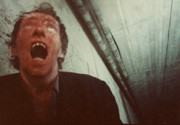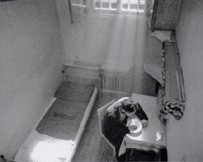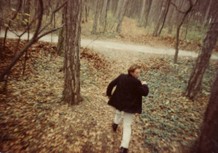 | | The messy business of being a killer |
The Anti-Hannibal Hannibal
Gerald Kargl's Angst
Steven Jay Schneider
Over the past forty or so years, serial killers in American cinema have undergone what can only be called an "evolution" of sorts. Psycho's Norman Bates (Anthony Perkins) may have been sweet enough when not in maniacal Mother mode, but nobody—not even poor Marion Crane—would have been inclined to take him for a cultured, engaging, or even particularly intelligent sort.
Following in Norman/Mother's bloody footsteps, well-known stalkers of the 1970s and 80s such as Leatherface, Michael Myers, and Jason Voorhees may have embodied "the manifestation of infantile, pre-Oedipal drives in their purest form: the death drive itself" [1]; but there was still something about them (if only their choice of victims) that made them, if not exactly personable, surprisingly endearing to their predominantly teenage viewing audience.
Since then, and especially in the 90s, serial killers in US cinema have tended to fall roughly into two camps: super-smart, highly imaginative, often quite sophisticated murderer-artists; or charismatic sociopaths with raw sexual appeal, little interest in art, and distinctly lowbrow tastes. In the former camp fall such creative killers as Seven's John Doe (Kevin Spacey), The Cell's Carl Stargher (Vincent D'Onofrio), The Apostate's Lewis Garou (Dennis Hopper), and reigning champion Hannibal "The Cannibal" Lecter (Brian Cox in Manhunter, followed by Anthony Hopkins in The Silence of the Lambs and Hannibal).
In the latter camp fall such charming, regressive, primitively attractive murderers as the eponymous Henry (Michael Rooker) in Henry: Portrait of a Serial Killer, Early Grayce (Brad Pitt) in Kalifornia, Vann Siegert (Owen Wilson) in The Minus Man, and the irrepressible Mickey and Mallory Knox (Woody Harrelson and Juliette Lewis) in Oliver Stone's Natural Born Killers. [2]
A different kind of killer
 The unnamed antagonist portrayed by Rudolf Götz in Angst (aka Fear)—an Austrian horror film-thriller directed by Gerald Kargl in 1983, and based on the real-life case of Salzburg-born triple murderer Werner Kniesek [3]—seems to have missed out on these various efforts at popularizing, romanticizing, and (above all) commercializing the cinematic serial killer. For Götz's character is neither charismatic nor creative, neither imaginative nor attractive…not even in a rough, uncultured sort of way. The unnamed antagonist portrayed by Rudolf Götz in Angst (aka Fear)—an Austrian horror film-thriller directed by Gerald Kargl in 1983, and based on the real-life case of Salzburg-born triple murderer Werner Kniesek [3]—seems to have missed out on these various efforts at popularizing, romanticizing, and (above all) commercializing the cinematic serial killer. For Götz's character is neither charismatic nor creative, neither imaginative nor attractive…not even in a rough, uncultured sort of way.
While he succeeds in slaughtering a bourgeois family of three—a young woman, her retarded, wheelchair-bound brother and their elderly mother—most viewers are apt to view him as a complete and utter failure, even when it comes to his chosen "profession." Early in the film, voiceover narration spoken by the killer while he is still in jail for an earlier crime [4] tells of a mysterious and malevolent plan that he has spent years perfecting, and that he promises to put into effect immediately upon his release. But this carefully-laid plan ("Everything was worked out down to the smallest detail"), one which seems to involve making things as terrifying as possible for his future victims, goes up in smoke every time he gets a chance to put it into effect.
Shortly after his release from prison, he bolts from a taxicab when the increasingly suspicious female driver suddenly stops the car. This scene, which begins in familiar fashion—the killer's voiceover tells us that the driver reminds him of his first girlfriend, "a real slut;" we see him playing with a cord in the backseat of the car, in preparation for his attack; suspenseful, Halloween-style music plays on the soundtrack [5] eventually thwarts our expectations by having the still-only would-be killer lose his nerve, panic, and make a break for it rather than enter a test of strength and will against his potential victim.
 Running through the woods at random, he stumbles upon an isolated house and his spirits rise once again: "What luck. This house was ideal for me. My plan was going to work." Hiding while the family who resides there returns home from an evening out, he quickly springs into action: knocking the son out of his wheelchair, he ties up the daughter and sets to work killing the mother by strangling her and stuffing paper down her throat. Running through the woods at random, he stumbles upon an isolated house and his spirits rise once again: "What luck. This house was ideal for me. My plan was going to work." Hiding while the family who resides there returns home from an evening out, he quickly springs into action: knocking the son out of his wheelchair, he ties up the daughter and sets to work killing the mother by strangling her and stuffing paper down her throat.
In one of the most disturbing—because so disturbingly realistic—fictional murder scenes ever committed to celluloid, we watch him struggle to kill the woman, who, despite her advanced age and apparent infirmity, puts up an amazing fight. Biting, scratching, clawing, and butting heads, the two wage distinctly unromantic battle before the woman, false teeth popping out of her mouth, finally loses consciousness.
Intelligently unenjoyable
Kargl's genius here is to show everything in real time, with numerous close-ups and diegetic sound. Viewers get to experience none of the pleasure (whether guilty or gleefully acknowledged) that comes from watching stylized, aestheticized killing—replete with slow-motion camerawork, overlapping edits and a meticulously composed mise-en-scene. Instead, writer-cinematographer Zbigniew Rybczynski alternates close-up point-of-view shots of the victim and her attacker and some canted overhead shots besides, constantly altering our relationship to the action.
We have no one to identify with, or rather, no one person with whom to identify, experiencing not only the old woman's terror but the killer's increasing excitement and determination as well. This in addition to the disgust and discomfort of an impotent witness, forced (by the camera) to observe and contemplate the scene from above.
"Everything's gone wrong. It all happened too quickly. This is not what was supposed to happen. It was to be much more dramatic. I had to keep to my plan. First the mother was to see her dead son... But she was not lying." Refusing to accept the fact that the woman has died, the killer stands her up, takes her in his arms, and drags her across the room—a grotesque danse macabre shot from a high angle for maximum impact. He even goes so far as to stuff meds down her throat, a desperate attempt at reviving her in order that he might kill her again, only more slowly this time, and with the daughter forced to watch.
Finally admitting "defeat," we learn the depths of his disappointment in voiceover: "I no longer was in complete control. A catastrophe." Hoping to redeem himself (to himself), he proceeds to drown the near-immobilized son in the upstairs bathroom, struggling even at this seemingly unchallenging task. His rampage culminates in the stabbing death of the daughter that evening, after which he has sex with the corpse, practically covering himself in her blood.
The utter lack of suspense in this scene, the director's refusal to gratify viewers by placing the young woman's body on display, and the emphasis on revealing the utterly compulsive, animalistic nature of the murderer's behavior (as opposed to spectacularizing his violent actions) all of this places Angst squarely at odds with mainstream American (and American-influenced) serial killer films.
The next morning, the killer drives to town in the family's car. Out of control behind the wheel, he hits another automobile from behind; when some curious schoolchildren venture near to find out what caused the accident, he has another attack of nerves, throws a fit, and abandons the vehicle. His erratic behavior, disheveled appearance and complete lack of interest in concealing his crimes lead to his arrest at a nearby diner, less than twenty four hours after his release from prison.
What makes Angst so interesting, even important—and what those viewers
hoping for the Austrian equivalent of Silence of the Lambs and Hannibal are bound to miss—is the fact that the film's numerous "failures" are precisely what constitutes its success. Not only the failures of the killer, whose grand scheme amounts to nothing more than three chaotic and wholly undignified murders. So too the failures of the director, who satisfies none of the genre's conventions, and who eschews the popular tradition of romanticizing the serial killer, of turning him into a sort of neo-Gothic anti-hero. [ 6]
Even more than Michael Rooker's Henry (modeled on prolific US multiple murderer Henry Lee Lucas)—a character described by at least one commentator as a "Marlon Brando/James Dean angry young rebel, complete with pout, mumbles, short curly hair, square jaw, and white T-shirt" [7]—Rudolf Götz's Werner Kniesek-inspired sociopath comes frighteningly close to providing us with a true "portrait" of a serial killer. And if we find that portrait less than appealing, and Angst that much more difficult to take because of it, this only speaks to the film's haunting power and strikingly original construction.
Steven Jay Schneider, 18 June 2001
Also by Steven Jay Schneider in CER:
Moving on:
Footnotes:
1. Reynold Humphries, "On the Road Again: Rehearsing the Death Drive in Modern Realist Horror," in Post Script: Essays in Film and the Humanities, forthcoming 2002.
2. Two serial killers who arguably problematize, or at least complicate, the breakdown suggested here are Francis Dollarhyde (Tom Noonan) of Manhunter and Paul White (David Keith) of White of the Eye. Both of these murderers display artistry as well as regressiveness, creativity in addition to raw sexuality. For more on these films and themes, see Steven Jay Schneider, "Murder as Art: The Art of Murder: Aestheticizing Violence in Modern Horror Cinema," in Necronomicon: The Journal of Horror and Erotic Cinema, Book 4, ed Andy Black (London: Noir Press), forthcoming 2001; and Steven Jay Schneider, "Killing In Style: The Aestheticization of Violence in Donald Cammell's White of the Eye," in Scope: An Online Journal of Film Studies, May 2001.
3. For a history of the Kniesek case and its relation to Angst, see Jürgen Felix and Marcus Stiglegger, "Psycho Killers and Home Invaders: The Austrian Horror-Thrillers Angst and Funny Games" in Fear Without Frontiers: Horror Cinema Across the Globe, ed Steven Jay Schneider (Guildford: FAB Press), forthcoming 2002. According to Felix and Stiglegger, Kniesek's 1980 trial after his arrest for killing a middle-aged widow and her two children (one of whom was disabled) became "as famous in Austria as the Fritz Haarmann and Peter Krten trials in Germany, or the Ed Gein case in America."
4. An unsuccessful attempt at matricide-shades of Psycho, but already we know he's no Norman.
5. The score for Angst was composed by Klaus Schulze, of the "Krautrock" group Tangerine Dream.
6. For a useful discussion of the Gothic origins of serial killer cinema, see Chapter 1 of Philip L Simpson's Psycho Paths: Tracking the Serial Killer Through Contemporary American Film and Fiction (Carbondale: Southern Illinois University Press), 2000.
7. Cynthia Freeland, "Realist Horror," in Philosophy and Film, ed Cynthia Freeland and Thomas Wartenberg (New York: Routledge), 1995: 131.
|
|




 The unnamed antagonist portrayed by Rudolf Götz in Angst (aka Fear)—an Austrian horror film-thriller directed by Gerald Kargl in 1983, and based on the real-life case of Salzburg-born triple murderer Werner Kniesek [
The unnamed antagonist portrayed by Rudolf Götz in Angst (aka Fear)—an Austrian horror film-thriller directed by Gerald Kargl in 1983, and based on the real-life case of Salzburg-born triple murderer Werner Kniesek [ Running through the woods at random, he stumbles upon an isolated house and his spirits rise once again: "What luck. This house was ideal for me. My plan was going to work." Hiding while the family who resides there returns home from an evening out, he quickly springs into action: knocking the son out of his wheelchair, he ties up the daughter and sets to work killing the mother by strangling her and stuffing paper down her throat.
Running through the woods at random, he stumbles upon an isolated house and his spirits rise once again: "What luck. This house was ideal for me. My plan was going to work." Hiding while the family who resides there returns home from an evening out, he quickly springs into action: knocking the son out of his wheelchair, he ties up the daughter and sets to work killing the mother by strangling her and stuffing paper down her throat.
